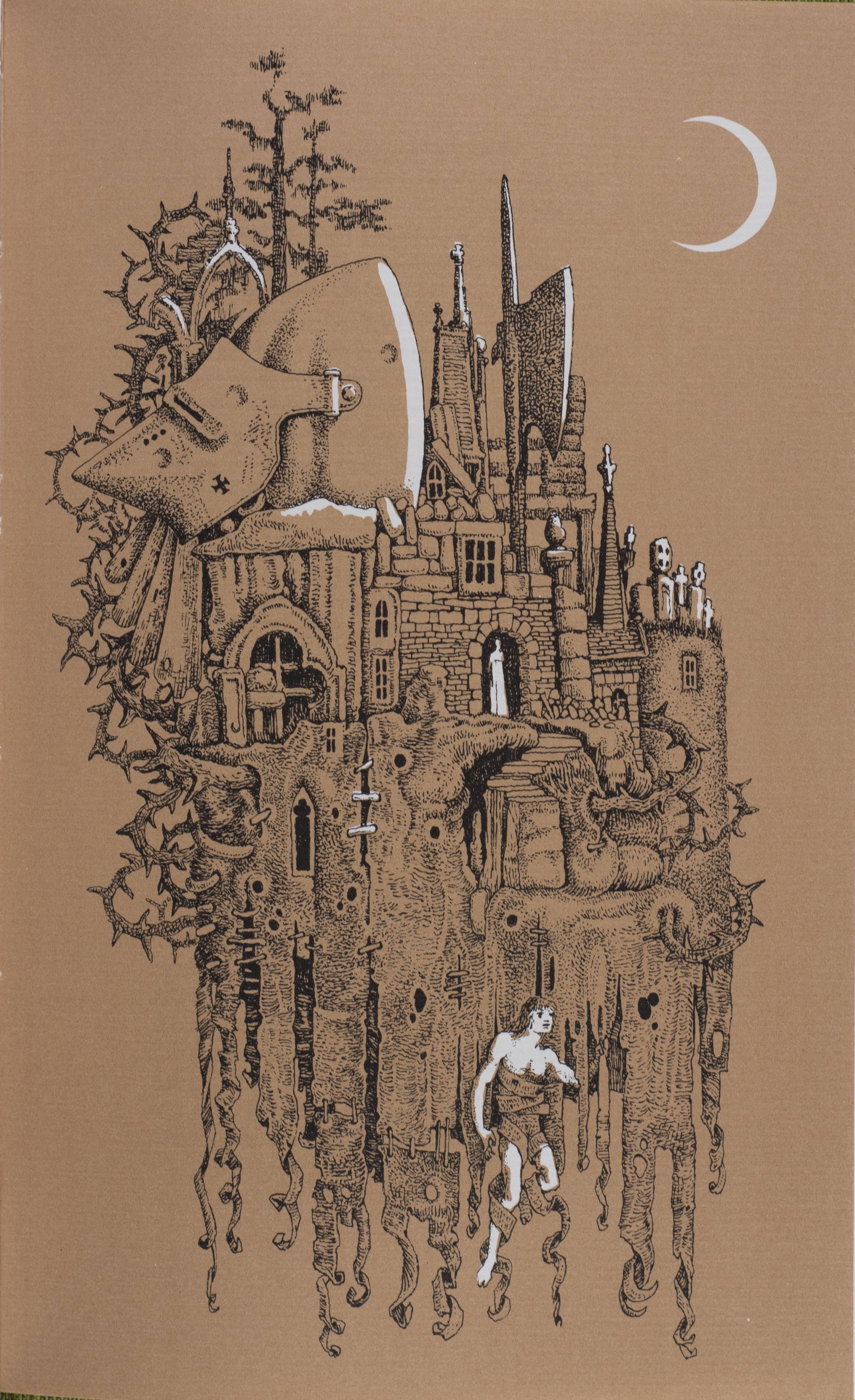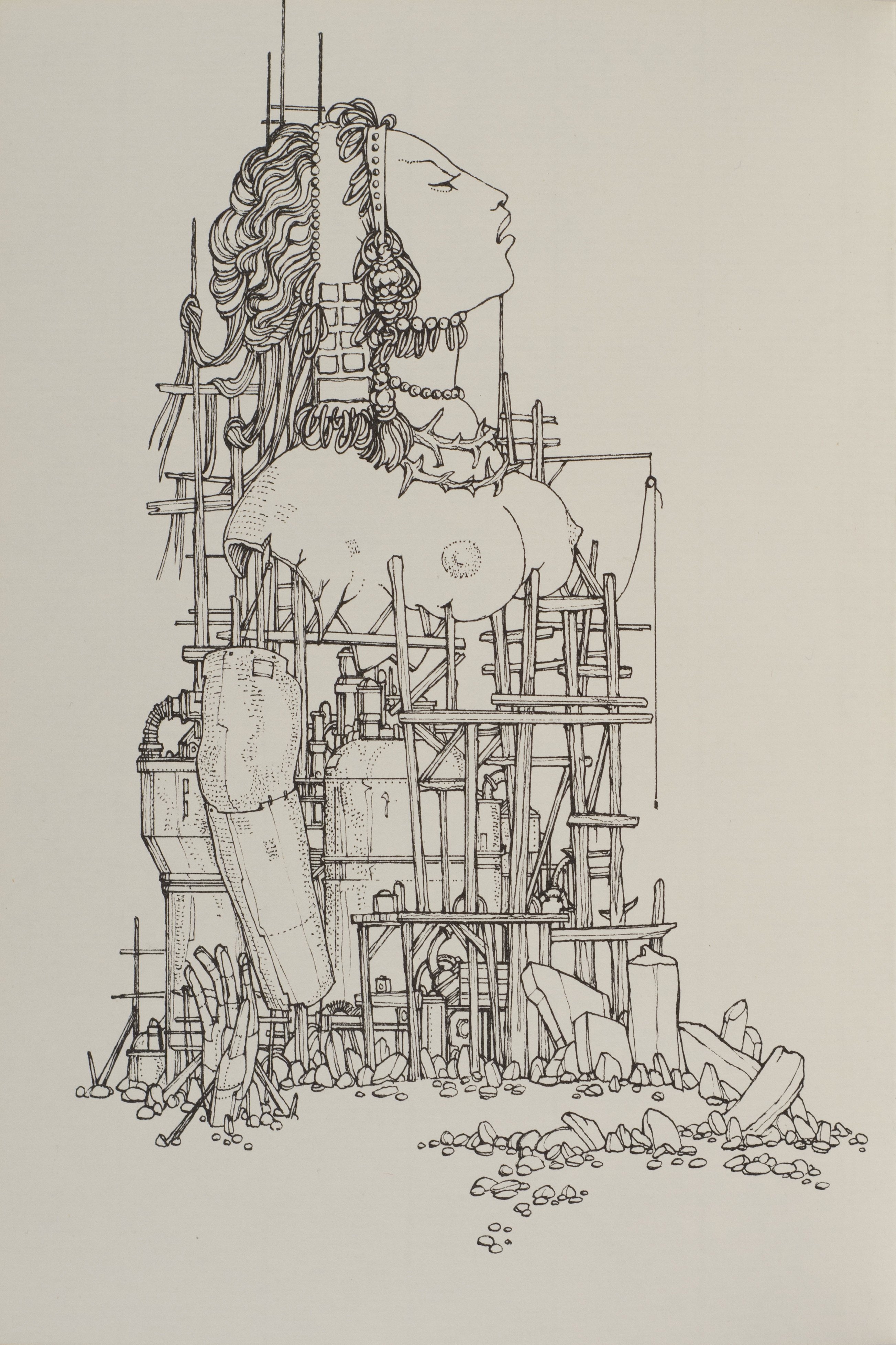Home > Themes > Degeneration
Degeneration
Virgil Burnett’s illustrations narrate the cycles of moral and physical degeneration and regeneration that document human history. Through symbols of decadence and decay, the illustrations tell the story of an overindulgent civilization redeemed by the resilience of the communal spirit. The illustration decorating the cover of Burnett’s Towers at the Edge of a World depicts a crumbling world dreamt up in the head of a hawk-human hybrid. This image displays civilization as a precarious idea, created by whimsy and subject to material erosion. However, Burnett’s images tell the story of a civilization redeemed by its ability to create and recreate through its organic, imaginative impulses. While the material elements of the drawings decay and corrupt, the beauty of the drawings’ decoration and fantastical elements demonstrate the power and breadth of artistic creativity.
 |
 |
Virgil Burnett, Towers at the Edge of the Word (Erin, Ont.: Porcupine's Quill, 1983)
|
A.D. Hope, The Damnation of Byron, illustrated by Virgil Burnett (Stratford, Ont.: Pasdeloup Press, 1973) |
| This image decorates the cover to a collection of short stories surrounding the fantastical town of Montarnis. In this illustration, Montarnis is represented as an ancient world of history, legend, and fantasy dreamt up in the head of a hybrid human-avian. The stoic hybrid’s head supports a dilapidated, decaying castle inhabited by ghostly figures and cracking under the weight of history and human ambition. The stories contained in Towers at the edge of a world tell of the rise and fall of a civilization from the Dark Ages to present. In Burnett’s sketch of a human civilization, he gets at themes of decadence and the creative and destructive powers of private impulses and imagination. These themes are reflected in the cover by Burnett’s choice to represent Montarnis as a place of lore created, monumentalized, yet allowed to decay by a part-human, part-animal creature.
|
This image of a writhing man adorned in strips of cloth, recalling classical sculptures, exaggerates and abstracts the emotion of the figure. By further covering his eyes with the invigorating curls of the cloth, the free-falling form becomes emblematic of one being haunted his emotions, or in this case the male figure’s wandering lust that will lead to his damnation as a Byronic figure. |
 |
 |
| Sir Gawain and the Green Knight, translated by Keith Harrison, lithographs by Virgil Burnett (London: Folio Society, 1983) |
Rienzi Crusz, Flesh and Thorn, illustrated by Virgil Burnett (Stratford, Ont.: Pasdeloup Press, 1974) |
| This illustration depicts an amorphous conglomeration of symbols of civilization and its natural decay. A man hangs entangled by shreds of cloth at the bottom of the figure, and the silhouette of a slim woman stands in a doorway of the precarious structure. Like the cover to Towers at the edge of a world, this image packs the symbols of civilization into a grotesque emblem of life, death, and material ephemerality |
The frontispiece to Rienzi Crusz’s book of poems, Flesh and Thorn, is a drawing of a nude bust of a woman, partially constructed and supported with wooden beams and industrial materials. Her face is raised painfully to the sky, and her body parts disintegrate into the material structure that supports it. Like many of Burnett’s drawings, it combines elements of human flesh with symbols of industry and civilization. The combination of the two draws similarities between the two and highlights the ephemeral nature of human flesh and its propensity to weaken and decay the same as any material substance in the natural world. |



